Current Development in Accounting Thoughts - University Assignment
VerifiedAdded on 2023/01/16
|11
|3430
|67
Essay
AI Summary
This essay delves into current developments in accounting, addressing three key questions. The first question explores the limitations of historical cost accounting in times of rising prices, contrasting it with fair value accounting. The second question examines the role of conceptual frameworks in shaping the accounting profession, debating whether they primarily aim to enhance public standing or serve other purposes. The third question investigates the link between measurement bases and users of general-purpose financial reporting, analyzing the shift from historical cost to fair value accounting and its implications for financial statement users. The essay incorporates relevant literature to support its arguments, offering a comprehensive overview of these critical accounting topics.
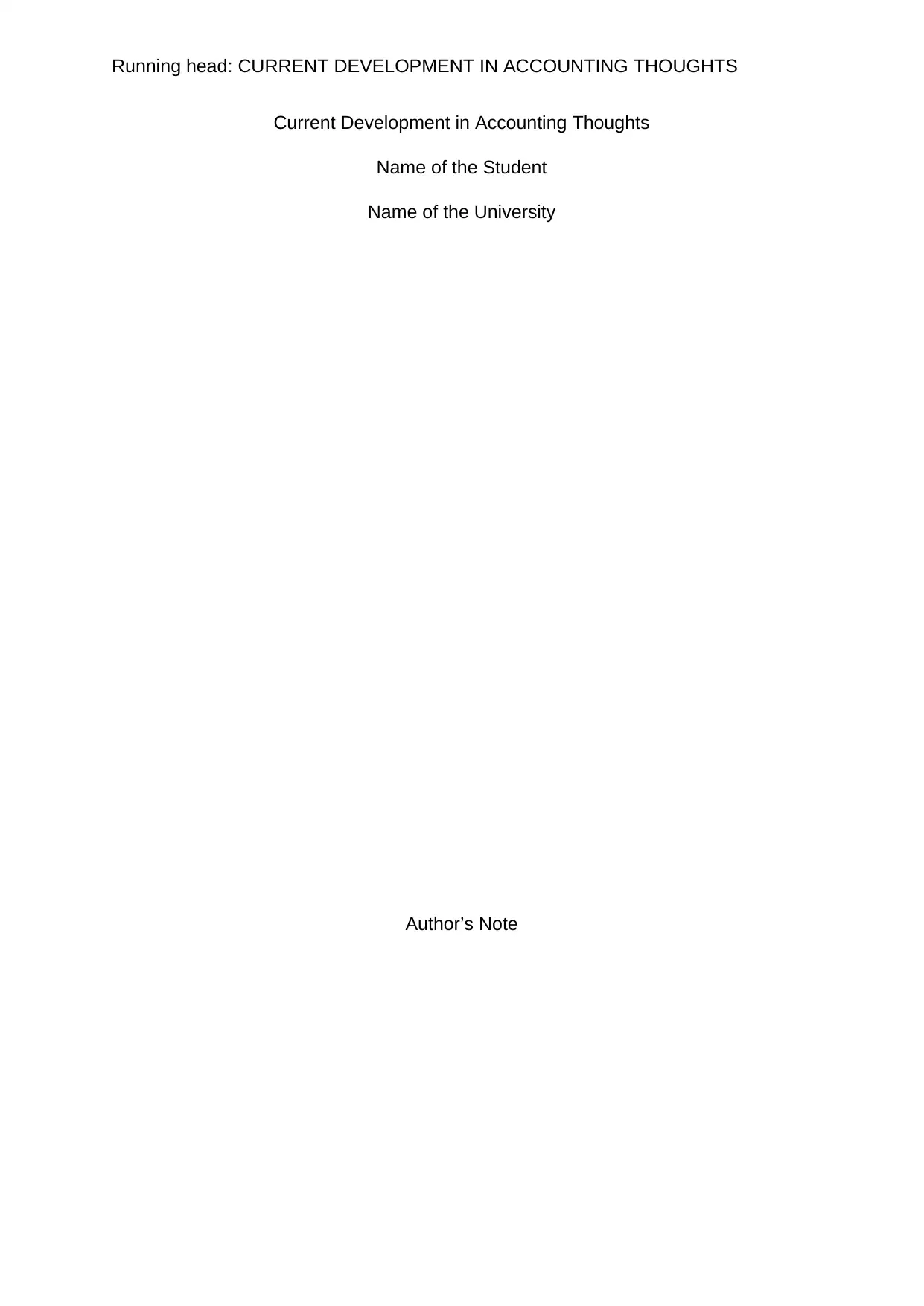
Running head: CURRENT DEVELOPMENT IN ACCOUNTING THOUGHTS
Current Development in Accounting Thoughts
Name of the Student
Name of the University
Author’s Note
Current Development in Accounting Thoughts
Name of the Student
Name of the University
Author’s Note
Paraphrase This Document
Need a fresh take? Get an instant paraphrase of this document with our AI Paraphraser
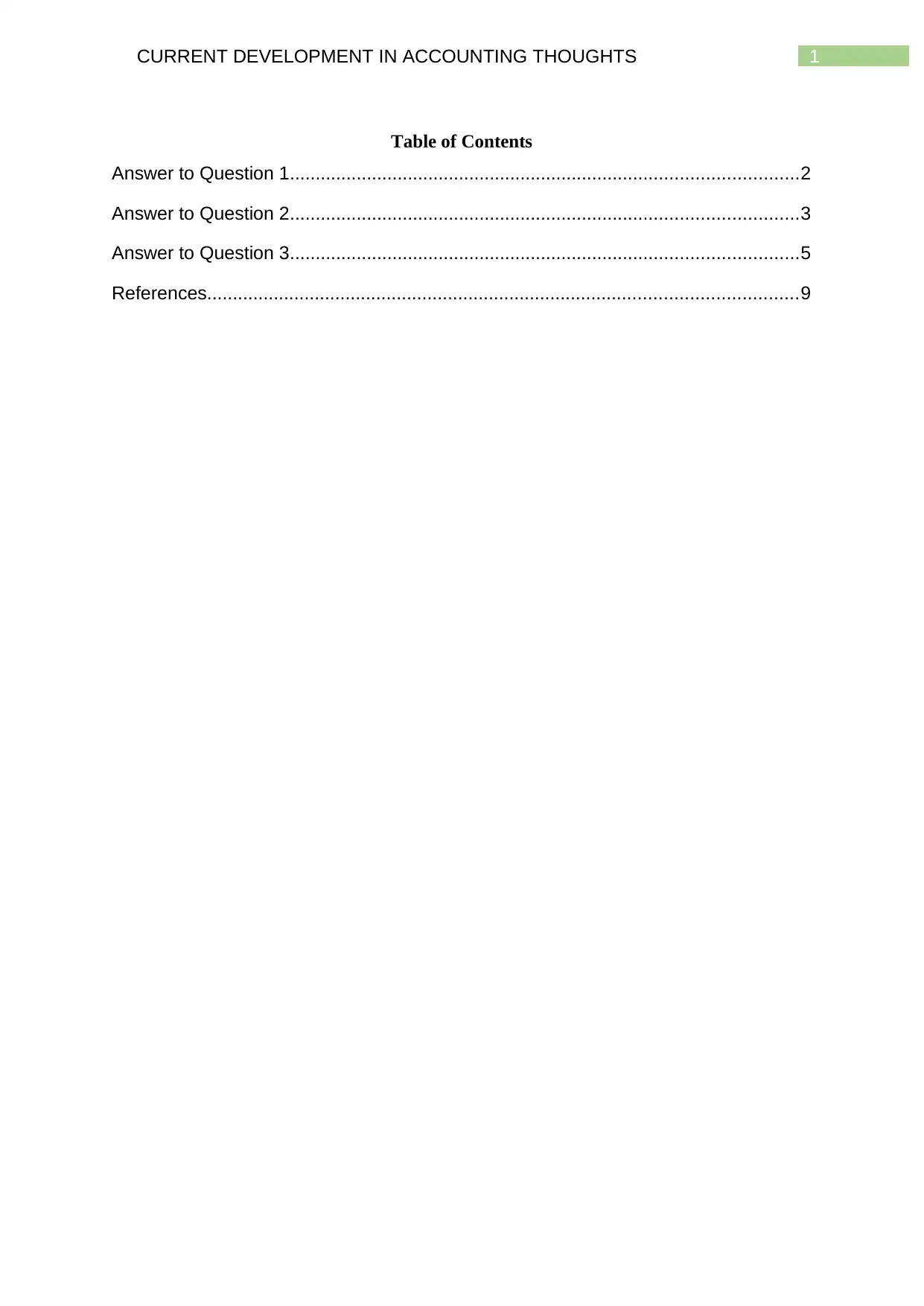
1CURRENT DEVELOPMENT IN ACCOUNTING THOUGHTS
Table of Contents
Answer to Question 1...................................................................................................2
Answer to Question 2...................................................................................................3
Answer to Question 3...................................................................................................5
References...................................................................................................................9
Table of Contents
Answer to Question 1...................................................................................................2
Answer to Question 2...................................................................................................3
Answer to Question 3...................................................................................................5
References...................................................................................................................9
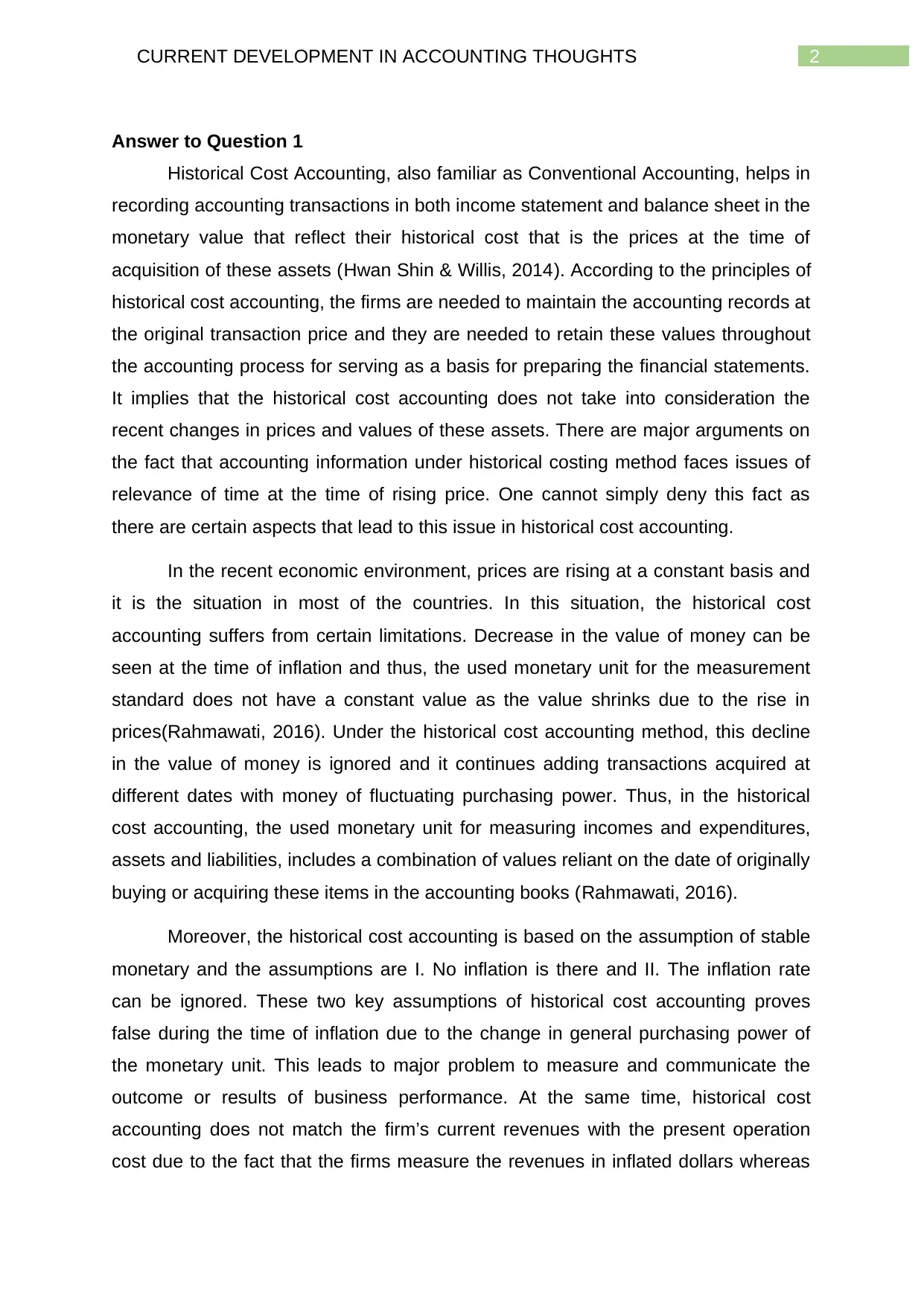
2CURRENT DEVELOPMENT IN ACCOUNTING THOUGHTS
Answer to Question 1
Historical Cost Accounting, also familiar as Conventional Accounting, helps in
recording accounting transactions in both income statement and balance sheet in the
monetary value that reflect their historical cost that is the prices at the time of
acquisition of these assets (Hwan Shin & Willis, 2014). According to the principles of
historical cost accounting, the firms are needed to maintain the accounting records at
the original transaction price and they are needed to retain these values throughout
the accounting process for serving as a basis for preparing the financial statements.
It implies that the historical cost accounting does not take into consideration the
recent changes in prices and values of these assets. There are major arguments on
the fact that accounting information under historical costing method faces issues of
relevance of time at the time of rising price. One cannot simply deny this fact as
there are certain aspects that lead to this issue in historical cost accounting.
In the recent economic environment, prices are rising at a constant basis and
it is the situation in most of the countries. In this situation, the historical cost
accounting suffers from certain limitations. Decrease in the value of money can be
seen at the time of inflation and thus, the used monetary unit for the measurement
standard does not have a constant value as the value shrinks due to the rise in
prices(Rahmawati, 2016). Under the historical cost accounting method, this decline
in the value of money is ignored and it continues adding transactions acquired at
different dates with money of fluctuating purchasing power. Thus, in the historical
cost accounting, the used monetary unit for measuring incomes and expenditures,
assets and liabilities, includes a combination of values reliant on the date of originally
buying or acquiring these items in the accounting books (Rahmawati, 2016).
Moreover, the historical cost accounting is based on the assumption of stable
monetary and the assumptions are I. No inflation is there and II. The inflation rate
can be ignored. These two key assumptions of historical cost accounting proves
false during the time of inflation due to the change in general purchasing power of
the monetary unit. This leads to major problem to measure and communicate the
outcome or results of business performance. At the same time, historical cost
accounting does not match the firm’s current revenues with the present operation
cost due to the fact that the firms measure the revenues in inflated dollars whereas
Answer to Question 1
Historical Cost Accounting, also familiar as Conventional Accounting, helps in
recording accounting transactions in both income statement and balance sheet in the
monetary value that reflect their historical cost that is the prices at the time of
acquisition of these assets (Hwan Shin & Willis, 2014). According to the principles of
historical cost accounting, the firms are needed to maintain the accounting records at
the original transaction price and they are needed to retain these values throughout
the accounting process for serving as a basis for preparing the financial statements.
It implies that the historical cost accounting does not take into consideration the
recent changes in prices and values of these assets. There are major arguments on
the fact that accounting information under historical costing method faces issues of
relevance of time at the time of rising price. One cannot simply deny this fact as
there are certain aspects that lead to this issue in historical cost accounting.
In the recent economic environment, prices are rising at a constant basis and
it is the situation in most of the countries. In this situation, the historical cost
accounting suffers from certain limitations. Decrease in the value of money can be
seen at the time of inflation and thus, the used monetary unit for the measurement
standard does not have a constant value as the value shrinks due to the rise in
prices(Rahmawati, 2016). Under the historical cost accounting method, this decline
in the value of money is ignored and it continues adding transactions acquired at
different dates with money of fluctuating purchasing power. Thus, in the historical
cost accounting, the used monetary unit for measuring incomes and expenditures,
assets and liabilities, includes a combination of values reliant on the date of originally
buying or acquiring these items in the accounting books (Rahmawati, 2016).
Moreover, the historical cost accounting is based on the assumption of stable
monetary and the assumptions are I. No inflation is there and II. The inflation rate
can be ignored. These two key assumptions of historical cost accounting proves
false during the time of inflation due to the change in general purchasing power of
the monetary unit. This leads to major problem to measure and communicate the
outcome or results of business performance. At the same time, historical cost
accounting does not match the firm’s current revenues with the present operation
cost due to the fact that the firms measure the revenues in inflated dollars whereas
⊘ This is a preview!⊘
Do you want full access?
Subscribe today to unlock all pages.

Trusted by 1+ million students worldwide
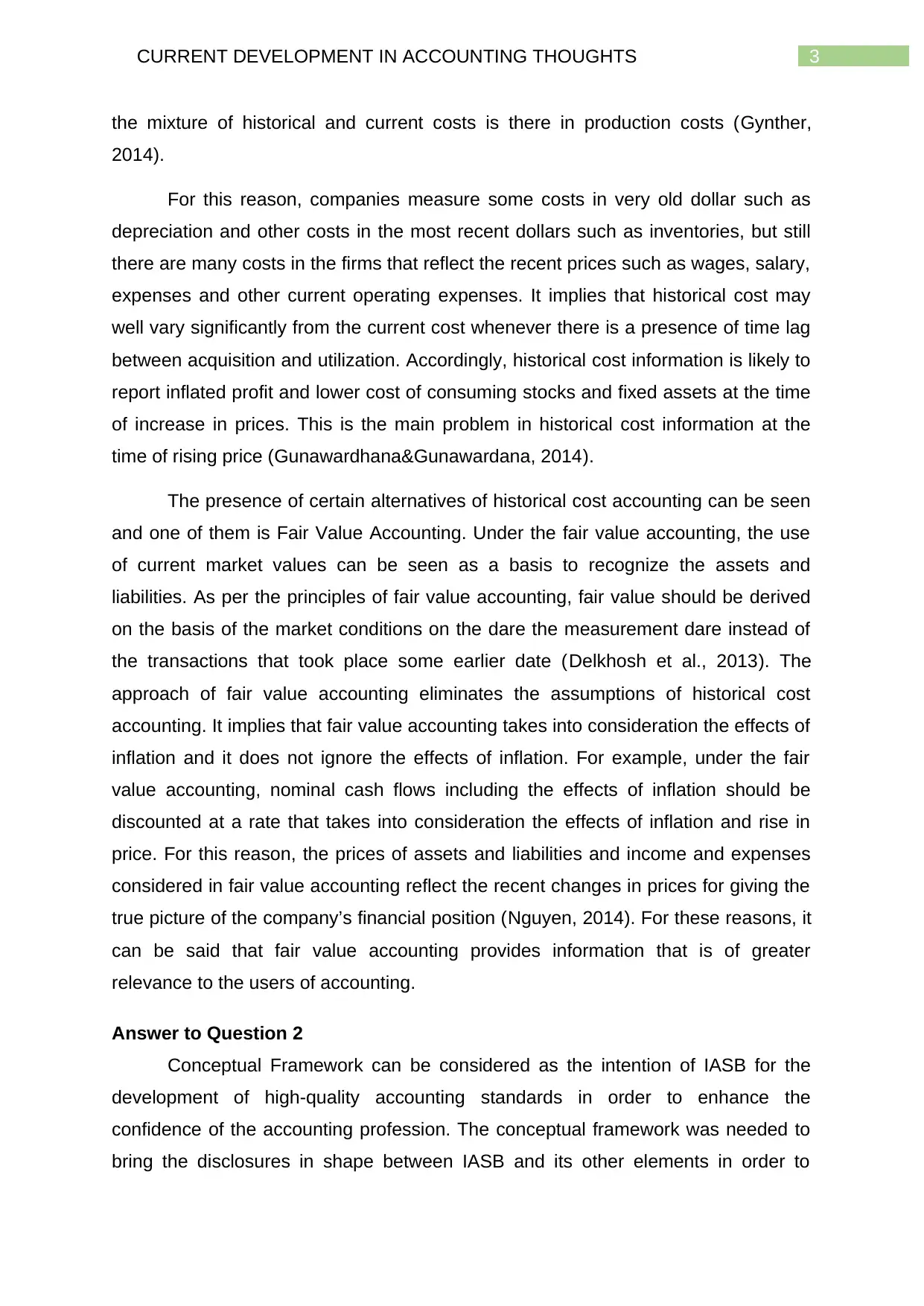
3CURRENT DEVELOPMENT IN ACCOUNTING THOUGHTS
the mixture of historical and current costs is there in production costs (Gynther,
2014).
For this reason, companies measure some costs in very old dollar such as
depreciation and other costs in the most recent dollars such as inventories, but still
there are many costs in the firms that reflect the recent prices such as wages, salary,
expenses and other current operating expenses. It implies that historical cost may
well vary significantly from the current cost whenever there is a presence of time lag
between acquisition and utilization. Accordingly, historical cost information is likely to
report inflated profit and lower cost of consuming stocks and fixed assets at the time
of increase in prices. This is the main problem in historical cost information at the
time of rising price (Gunawardhana&Gunawardana, 2014).
The presence of certain alternatives of historical cost accounting can be seen
and one of them is Fair Value Accounting. Under the fair value accounting, the use
of current market values can be seen as a basis to recognize the assets and
liabilities. As per the principles of fair value accounting, fair value should be derived
on the basis of the market conditions on the dare the measurement dare instead of
the transactions that took place some earlier date (Delkhosh et al., 2013). The
approach of fair value accounting eliminates the assumptions of historical cost
accounting. It implies that fair value accounting takes into consideration the effects of
inflation and it does not ignore the effects of inflation. For example, under the fair
value accounting, nominal cash flows including the effects of inflation should be
discounted at a rate that takes into consideration the effects of inflation and rise in
price. For this reason, the prices of assets and liabilities and income and expenses
considered in fair value accounting reflect the recent changes in prices for giving the
true picture of the company’s financial position (Nguyen, 2014). For these reasons, it
can be said that fair value accounting provides information that is of greater
relevance to the users of accounting.
Answer to Question 2
Conceptual Framework can be considered as the intention of IASB for the
development of high-quality accounting standards in order to enhance the
confidence of the accounting profession. The conceptual framework was needed to
bring the disclosures in shape between IASB and its other elements in order to
the mixture of historical and current costs is there in production costs (Gynther,
2014).
For this reason, companies measure some costs in very old dollar such as
depreciation and other costs in the most recent dollars such as inventories, but still
there are many costs in the firms that reflect the recent prices such as wages, salary,
expenses and other current operating expenses. It implies that historical cost may
well vary significantly from the current cost whenever there is a presence of time lag
between acquisition and utilization. Accordingly, historical cost information is likely to
report inflated profit and lower cost of consuming stocks and fixed assets at the time
of increase in prices. This is the main problem in historical cost information at the
time of rising price (Gunawardhana&Gunawardana, 2014).
The presence of certain alternatives of historical cost accounting can be seen
and one of them is Fair Value Accounting. Under the fair value accounting, the use
of current market values can be seen as a basis to recognize the assets and
liabilities. As per the principles of fair value accounting, fair value should be derived
on the basis of the market conditions on the dare the measurement dare instead of
the transactions that took place some earlier date (Delkhosh et al., 2013). The
approach of fair value accounting eliminates the assumptions of historical cost
accounting. It implies that fair value accounting takes into consideration the effects of
inflation and it does not ignore the effects of inflation. For example, under the fair
value accounting, nominal cash flows including the effects of inflation should be
discounted at a rate that takes into consideration the effects of inflation and rise in
price. For this reason, the prices of assets and liabilities and income and expenses
considered in fair value accounting reflect the recent changes in prices for giving the
true picture of the company’s financial position (Nguyen, 2014). For these reasons, it
can be said that fair value accounting provides information that is of greater
relevance to the users of accounting.
Answer to Question 2
Conceptual Framework can be considered as the intention of IASB for the
development of high-quality accounting standards in order to enhance the
confidence of the accounting profession. The conceptual framework was needed to
bring the disclosures in shape between IASB and its other elements in order to
Paraphrase This Document
Need a fresh take? Get an instant paraphrase of this document with our AI Paraphraser
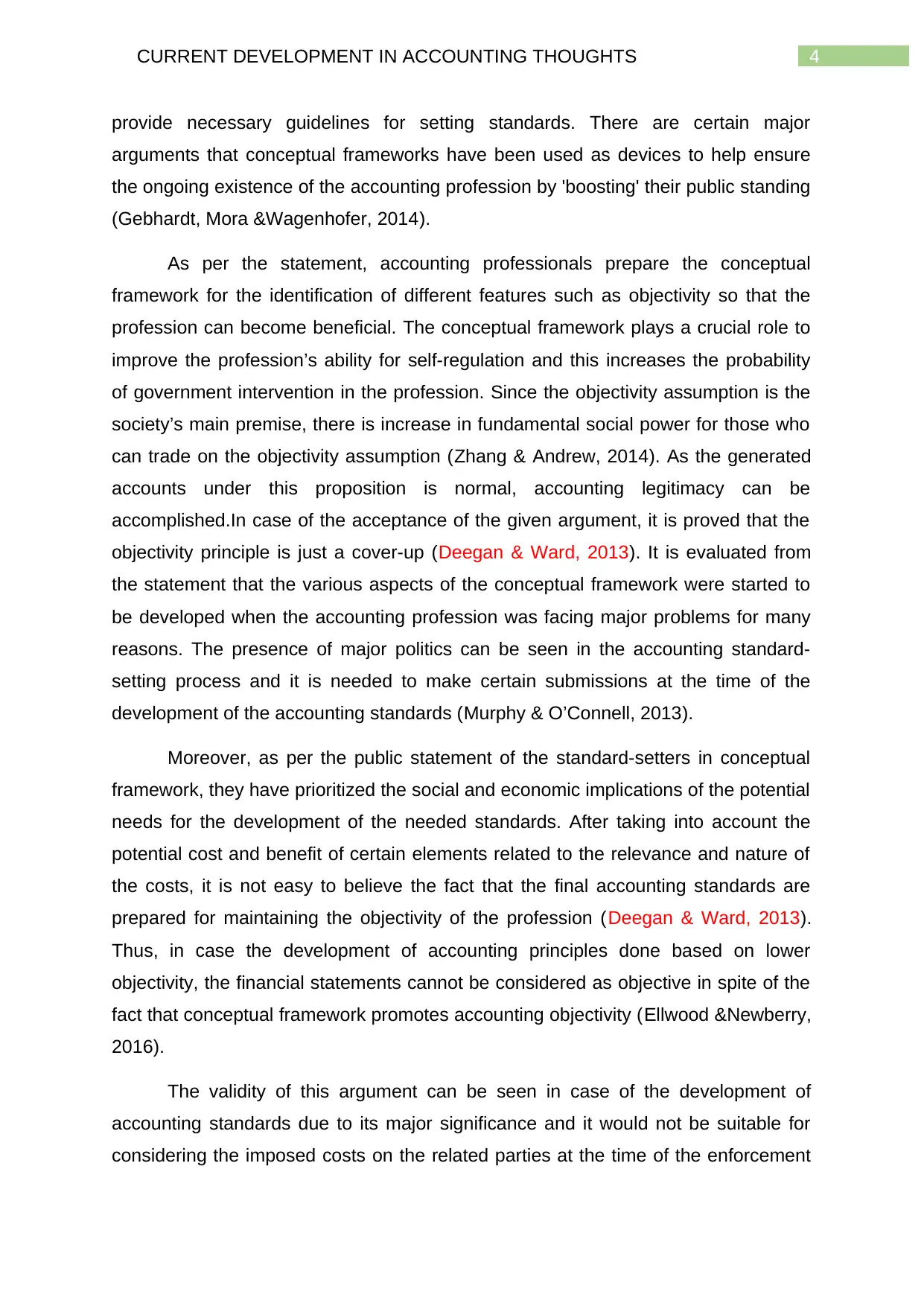
4CURRENT DEVELOPMENT IN ACCOUNTING THOUGHTS
provide necessary guidelines for setting standards. There are certain major
arguments that conceptual frameworks have been used as devices to help ensure
the ongoing existence of the accounting profession by 'boosting' their public standing
(Gebhardt, Mora &Wagenhofer, 2014).
As per the statement, accounting professionals prepare the conceptual
framework for the identification of different features such as objectivity so that the
profession can become beneficial. The conceptual framework plays a crucial role to
improve the profession’s ability for self-regulation and this increases the probability
of government intervention in the profession. Since the objectivity assumption is the
society’s main premise, there is increase in fundamental social power for those who
can trade on the objectivity assumption (Zhang & Andrew, 2014). As the generated
accounts under this proposition is normal, accounting legitimacy can be
accomplished.In case of the acceptance of the given argument, it is proved that the
objectivity principle is just a cover-up (Deegan & Ward, 2013). It is evaluated from
the statement that the various aspects of the conceptual framework were started to
be developed when the accounting profession was facing major problems for many
reasons. The presence of major politics can be seen in the accounting standard-
setting process and it is needed to make certain submissions at the time of the
development of the accounting standards (Murphy & O’Connell, 2013).
Moreover, as per the public statement of the standard-setters in conceptual
framework, they have prioritized the social and economic implications of the potential
needs for the development of the needed standards. After taking into account the
potential cost and benefit of certain elements related to the relevance and nature of
the costs, it is not easy to believe the fact that the final accounting standards are
prepared for maintaining the objectivity of the profession (Deegan & Ward, 2013).
Thus, in case the development of accounting principles done based on lower
objectivity, the financial statements cannot be considered as objective in spite of the
fact that conceptual framework promotes accounting objectivity (Ellwood &Newberry,
2016).
The validity of this argument can be seen in case of the development of
accounting standards due to its major significance and it would not be suitable for
considering the imposed costs on the related parties at the time of the enforcement
provide necessary guidelines for setting standards. There are certain major
arguments that conceptual frameworks have been used as devices to help ensure
the ongoing existence of the accounting profession by 'boosting' their public standing
(Gebhardt, Mora &Wagenhofer, 2014).
As per the statement, accounting professionals prepare the conceptual
framework for the identification of different features such as objectivity so that the
profession can become beneficial. The conceptual framework plays a crucial role to
improve the profession’s ability for self-regulation and this increases the probability
of government intervention in the profession. Since the objectivity assumption is the
society’s main premise, there is increase in fundamental social power for those who
can trade on the objectivity assumption (Zhang & Andrew, 2014). As the generated
accounts under this proposition is normal, accounting legitimacy can be
accomplished.In case of the acceptance of the given argument, it is proved that the
objectivity principle is just a cover-up (Deegan & Ward, 2013). It is evaluated from
the statement that the various aspects of the conceptual framework were started to
be developed when the accounting profession was facing major problems for many
reasons. The presence of major politics can be seen in the accounting standard-
setting process and it is needed to make certain submissions at the time of the
development of the accounting standards (Murphy & O’Connell, 2013).
Moreover, as per the public statement of the standard-setters in conceptual
framework, they have prioritized the social and economic implications of the potential
needs for the development of the needed standards. After taking into account the
potential cost and benefit of certain elements related to the relevance and nature of
the costs, it is not easy to believe the fact that the final accounting standards are
prepared for maintaining the objectivity of the profession (Deegan & Ward, 2013).
Thus, in case the development of accounting principles done based on lower
objectivity, the financial statements cannot be considered as objective in spite of the
fact that conceptual framework promotes accounting objectivity (Ellwood &Newberry,
2016).
The validity of this argument can be seen in case of the development of
accounting standards due to its major significance and it would not be suitable for
considering the imposed costs on the related parties at the time of the enforcement
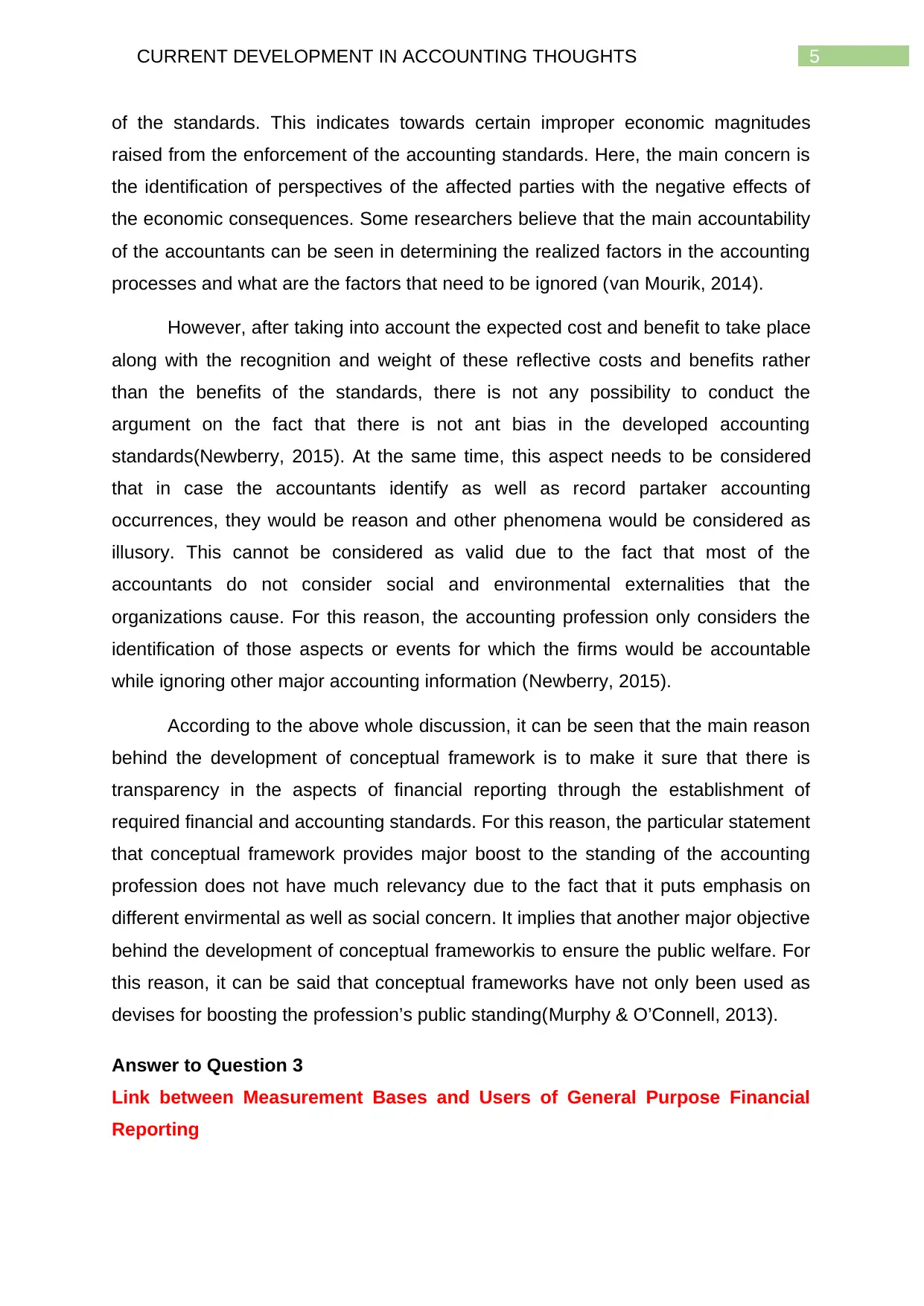
5CURRENT DEVELOPMENT IN ACCOUNTING THOUGHTS
of the standards. This indicates towards certain improper economic magnitudes
raised from the enforcement of the accounting standards. Here, the main concern is
the identification of perspectives of the affected parties with the negative effects of
the economic consequences. Some researchers believe that the main accountability
of the accountants can be seen in determining the realized factors in the accounting
processes and what are the factors that need to be ignored (van Mourik, 2014).
However, after taking into account the expected cost and benefit to take place
along with the recognition and weight of these reflective costs and benefits rather
than the benefits of the standards, there is not any possibility to conduct the
argument on the fact that there is not ant bias in the developed accounting
standards(Newberry, 2015). At the same time, this aspect needs to be considered
that in case the accountants identify as well as record partaker accounting
occurrences, they would be reason and other phenomena would be considered as
illusory. This cannot be considered as valid due to the fact that most of the
accountants do not consider social and environmental externalities that the
organizations cause. For this reason, the accounting profession only considers the
identification of those aspects or events for which the firms would be accountable
while ignoring other major accounting information (Newberry, 2015).
According to the above whole discussion, it can be seen that the main reason
behind the development of conceptual framework is to make it sure that there is
transparency in the aspects of financial reporting through the establishment of
required financial and accounting standards. For this reason, the particular statement
that conceptual framework provides major boost to the standing of the accounting
profession does not have much relevancy due to the fact that it puts emphasis on
different envirmental as well as social concern. It implies that another major objective
behind the development of conceptual frameworkis to ensure the public welfare. For
this reason, it can be said that conceptual frameworks have not only been used as
devises for boosting the profession’s public standing(Murphy & O’Connell, 2013).
Answer to Question 3
Link between Measurement Bases and Users of General Purpose Financial
Reporting
of the standards. This indicates towards certain improper economic magnitudes
raised from the enforcement of the accounting standards. Here, the main concern is
the identification of perspectives of the affected parties with the negative effects of
the economic consequences. Some researchers believe that the main accountability
of the accountants can be seen in determining the realized factors in the accounting
processes and what are the factors that need to be ignored (van Mourik, 2014).
However, after taking into account the expected cost and benefit to take place
along with the recognition and weight of these reflective costs and benefits rather
than the benefits of the standards, there is not any possibility to conduct the
argument on the fact that there is not ant bias in the developed accounting
standards(Newberry, 2015). At the same time, this aspect needs to be considered
that in case the accountants identify as well as record partaker accounting
occurrences, they would be reason and other phenomena would be considered as
illusory. This cannot be considered as valid due to the fact that most of the
accountants do not consider social and environmental externalities that the
organizations cause. For this reason, the accounting profession only considers the
identification of those aspects or events for which the firms would be accountable
while ignoring other major accounting information (Newberry, 2015).
According to the above whole discussion, it can be seen that the main reason
behind the development of conceptual framework is to make it sure that there is
transparency in the aspects of financial reporting through the establishment of
required financial and accounting standards. For this reason, the particular statement
that conceptual framework provides major boost to the standing of the accounting
profession does not have much relevancy due to the fact that it puts emphasis on
different envirmental as well as social concern. It implies that another major objective
behind the development of conceptual frameworkis to ensure the public welfare. For
this reason, it can be said that conceptual frameworks have not only been used as
devises for boosting the profession’s public standing(Murphy & O’Connell, 2013).
Answer to Question 3
Link between Measurement Bases and Users of General Purpose Financial
Reporting
⊘ This is a preview!⊘
Do you want full access?
Subscribe today to unlock all pages.

Trusted by 1+ million students worldwide
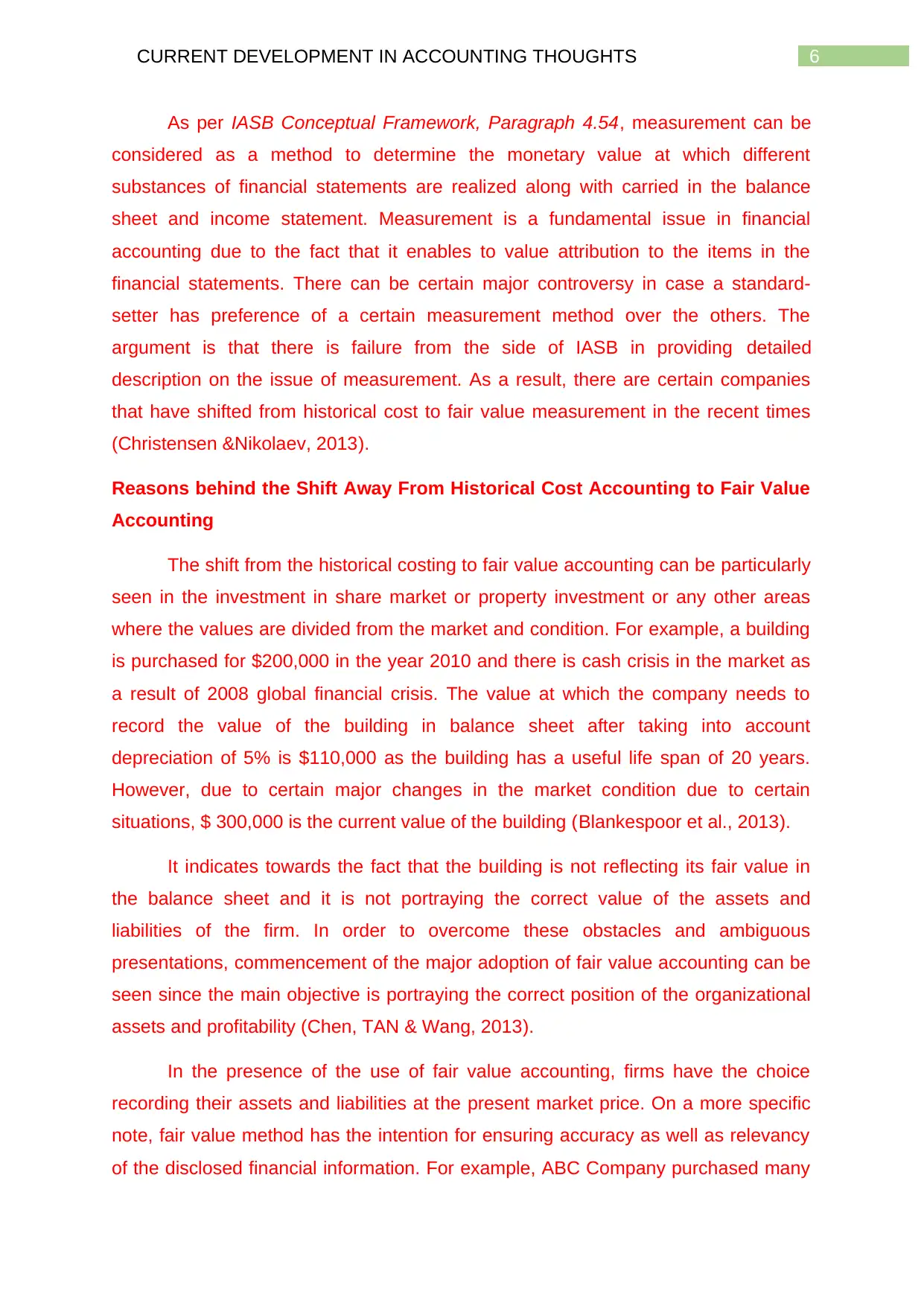
6CURRENT DEVELOPMENT IN ACCOUNTING THOUGHTS
As per IASB Conceptual Framework, Paragraph 4.54, measurement can be
considered as a method to determine the monetary value at which different
substances of financial statements are realized along with carried in the balance
sheet and income statement. Measurement is a fundamental issue in financial
accounting due to the fact that it enables to value attribution to the items in the
financial statements. There can be certain major controversy in case a standard-
setter has preference of a certain measurement method over the others. The
argument is that there is failure from the side of IASB in providing detailed
description on the issue of measurement. As a result, there are certain companies
that have shifted from historical cost to fair value measurement in the recent times
(Christensen &Nikolaev, 2013).
Reasons behind the Shift Away From Historical Cost Accounting to Fair Value
Accounting
The shift from the historical costing to fair value accounting can be particularly
seen in the investment in share market or property investment or any other areas
where the values are divided from the market and condition. For example, a building
is purchased for $200,000 in the year 2010 and there is cash crisis in the market as
a result of 2008 global financial crisis. The value at which the company needs to
record the value of the building in balance sheet after taking into account
depreciation of 5% is $110,000 as the building has a useful life span of 20 years.
However, due to certain major changes in the market condition due to certain
situations, $ 300,000 is the current value of the building (Blankespoor et al., 2013).
It indicates towards the fact that the building is not reflecting its fair value in
the balance sheet and it is not portraying the correct value of the assets and
liabilities of the firm. In order to overcome these obstacles and ambiguous
presentations, commencement of the major adoption of fair value accounting can be
seen since the main objective is portraying the correct position of the organizational
assets and profitability (Chen, TAN & Wang, 2013).
In the presence of the use of fair value accounting, firms have the choice
recording their assets and liabilities at the present market price. On a more specific
note, fair value method has the intention for ensuring accuracy as well as relevancy
of the disclosed financial information. For example, ABC Company purchased many
As per IASB Conceptual Framework, Paragraph 4.54, measurement can be
considered as a method to determine the monetary value at which different
substances of financial statements are realized along with carried in the balance
sheet and income statement. Measurement is a fundamental issue in financial
accounting due to the fact that it enables to value attribution to the items in the
financial statements. There can be certain major controversy in case a standard-
setter has preference of a certain measurement method over the others. The
argument is that there is failure from the side of IASB in providing detailed
description on the issue of measurement. As a result, there are certain companies
that have shifted from historical cost to fair value measurement in the recent times
(Christensen &Nikolaev, 2013).
Reasons behind the Shift Away From Historical Cost Accounting to Fair Value
Accounting
The shift from the historical costing to fair value accounting can be particularly
seen in the investment in share market or property investment or any other areas
where the values are divided from the market and condition. For example, a building
is purchased for $200,000 in the year 2010 and there is cash crisis in the market as
a result of 2008 global financial crisis. The value at which the company needs to
record the value of the building in balance sheet after taking into account
depreciation of 5% is $110,000 as the building has a useful life span of 20 years.
However, due to certain major changes in the market condition due to certain
situations, $ 300,000 is the current value of the building (Blankespoor et al., 2013).
It indicates towards the fact that the building is not reflecting its fair value in
the balance sheet and it is not portraying the correct value of the assets and
liabilities of the firm. In order to overcome these obstacles and ambiguous
presentations, commencement of the major adoption of fair value accounting can be
seen since the main objective is portraying the correct position of the organizational
assets and profitability (Chen, TAN & Wang, 2013).
In the presence of the use of fair value accounting, firms have the choice
recording their assets and liabilities at the present market price. On a more specific
note, fair value method has the intention for ensuring accuracy as well as relevancy
of the disclosed financial information. For example, ABC Company purchased many
Paraphrase This Document
Need a fresh take? Get an instant paraphrase of this document with our AI Paraphraser
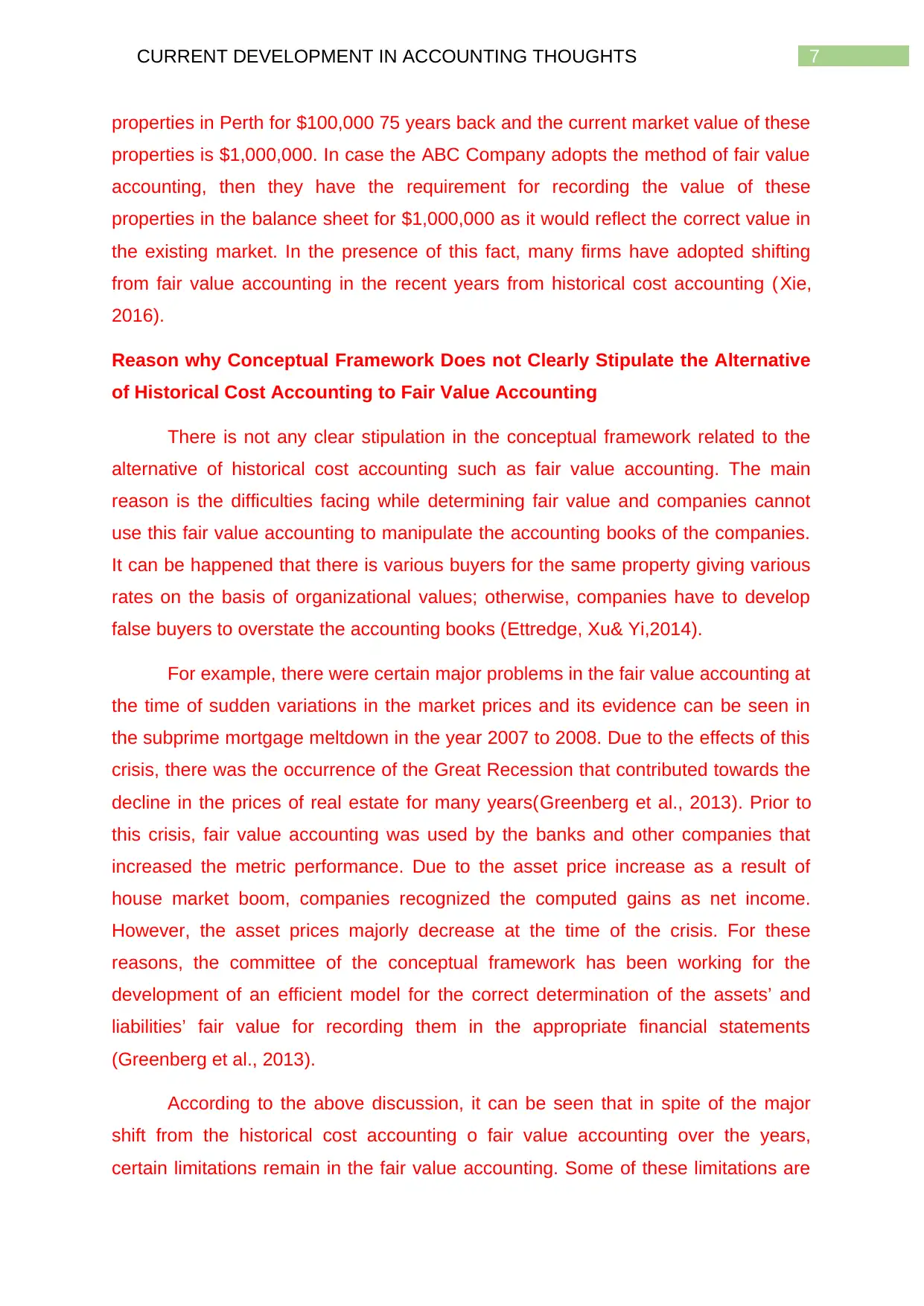
7CURRENT DEVELOPMENT IN ACCOUNTING THOUGHTS
properties in Perth for $100,000 75 years back and the current market value of these
properties is $1,000,000. In case the ABC Company adopts the method of fair value
accounting, then they have the requirement for recording the value of these
properties in the balance sheet for $1,000,000 as it would reflect the correct value in
the existing market. In the presence of this fact, many firms have adopted shifting
from fair value accounting in the recent years from historical cost accounting (Xie,
2016).
Reason why Conceptual Framework Does not Clearly Stipulate the Alternative
of Historical Cost Accounting to Fair Value Accounting
There is not any clear stipulation in the conceptual framework related to the
alternative of historical cost accounting such as fair value accounting. The main
reason is the difficulties facing while determining fair value and companies cannot
use this fair value accounting to manipulate the accounting books of the companies.
It can be happened that there is various buyers for the same property giving various
rates on the basis of organizational values; otherwise, companies have to develop
false buyers to overstate the accounting books (Ettredge, Xu& Yi,2014).
For example, there were certain major problems in the fair value accounting at
the time of sudden variations in the market prices and its evidence can be seen in
the subprime mortgage meltdown in the year 2007 to 2008. Due to the effects of this
crisis, there was the occurrence of the Great Recession that contributed towards the
decline in the prices of real estate for many years(Greenberg et al., 2013). Prior to
this crisis, fair value accounting was used by the banks and other companies that
increased the metric performance. Due to the asset price increase as a result of
house market boom, companies recognized the computed gains as net income.
However, the asset prices majorly decrease at the time of the crisis. For these
reasons, the committee of the conceptual framework has been working for the
development of an efficient model for the correct determination of the assets’ and
liabilities’ fair value for recording them in the appropriate financial statements
(Greenberg et al., 2013).
According to the above discussion, it can be seen that in spite of the major
shift from the historical cost accounting o fair value accounting over the years,
certain limitations remain in the fair value accounting. Some of these limitations are
properties in Perth for $100,000 75 years back and the current market value of these
properties is $1,000,000. In case the ABC Company adopts the method of fair value
accounting, then they have the requirement for recording the value of these
properties in the balance sheet for $1,000,000 as it would reflect the correct value in
the existing market. In the presence of this fact, many firms have adopted shifting
from fair value accounting in the recent years from historical cost accounting (Xie,
2016).
Reason why Conceptual Framework Does not Clearly Stipulate the Alternative
of Historical Cost Accounting to Fair Value Accounting
There is not any clear stipulation in the conceptual framework related to the
alternative of historical cost accounting such as fair value accounting. The main
reason is the difficulties facing while determining fair value and companies cannot
use this fair value accounting to manipulate the accounting books of the companies.
It can be happened that there is various buyers for the same property giving various
rates on the basis of organizational values; otherwise, companies have to develop
false buyers to overstate the accounting books (Ettredge, Xu& Yi,2014).
For example, there were certain major problems in the fair value accounting at
the time of sudden variations in the market prices and its evidence can be seen in
the subprime mortgage meltdown in the year 2007 to 2008. Due to the effects of this
crisis, there was the occurrence of the Great Recession that contributed towards the
decline in the prices of real estate for many years(Greenberg et al., 2013). Prior to
this crisis, fair value accounting was used by the banks and other companies that
increased the metric performance. Due to the asset price increase as a result of
house market boom, companies recognized the computed gains as net income.
However, the asset prices majorly decrease at the time of the crisis. For these
reasons, the committee of the conceptual framework has been working for the
development of an efficient model for the correct determination of the assets’ and
liabilities’ fair value for recording them in the appropriate financial statements
(Greenberg et al., 2013).
According to the above discussion, it can be seen that in spite of the major
shift from the historical cost accounting o fair value accounting over the years,
certain limitations remain in the fair value accounting. Some of these limitations are
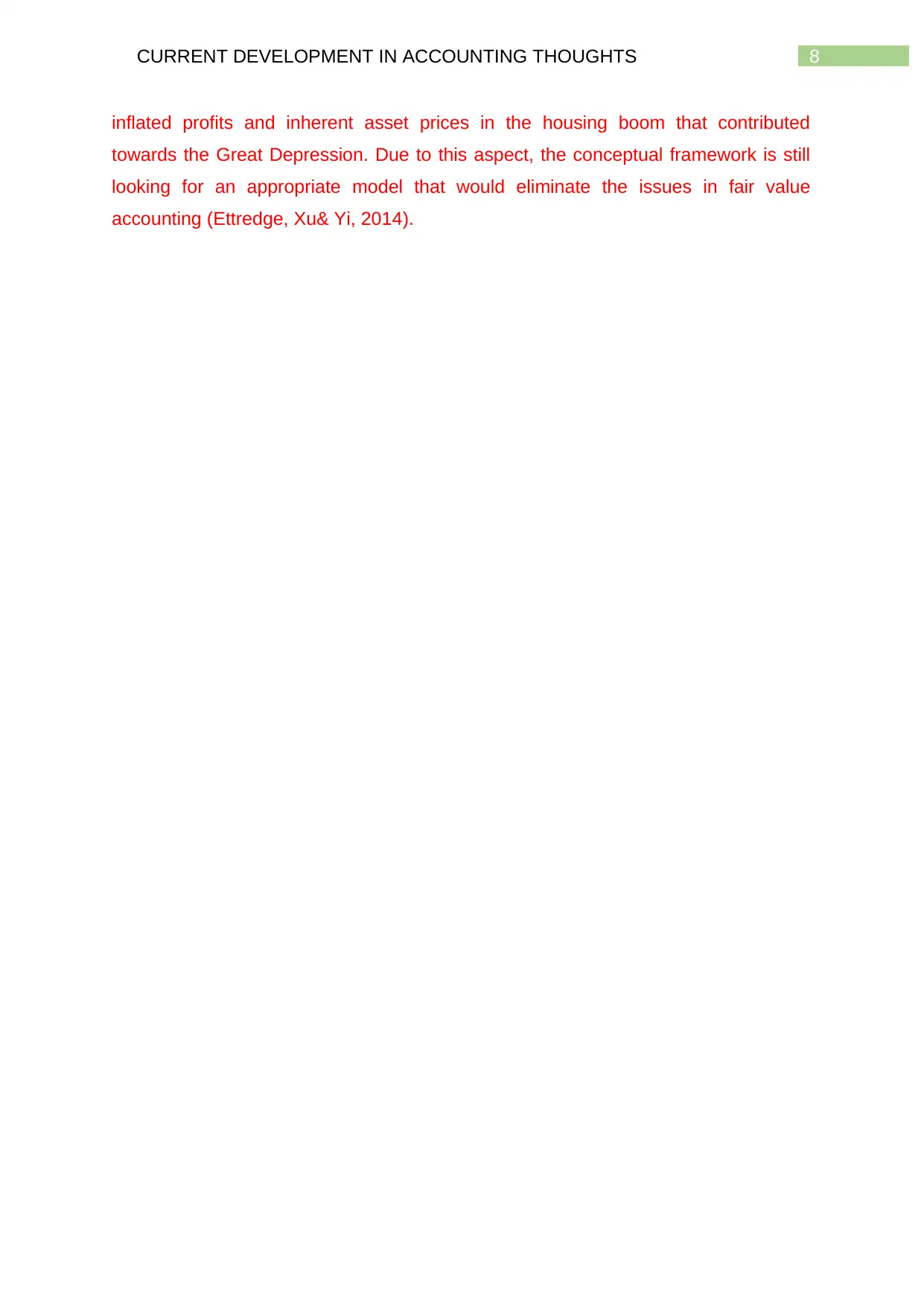
8CURRENT DEVELOPMENT IN ACCOUNTING THOUGHTS
inflated profits and inherent asset prices in the housing boom that contributed
towards the Great Depression. Due to this aspect, the conceptual framework is still
looking for an appropriate model that would eliminate the issues in fair value
accounting (Ettredge, Xu& Yi, 2014).
inflated profits and inherent asset prices in the housing boom that contributed
towards the Great Depression. Due to this aspect, the conceptual framework is still
looking for an appropriate model that would eliminate the issues in fair value
accounting (Ettredge, Xu& Yi, 2014).
⊘ This is a preview!⊘
Do you want full access?
Subscribe today to unlock all pages.

Trusted by 1+ million students worldwide
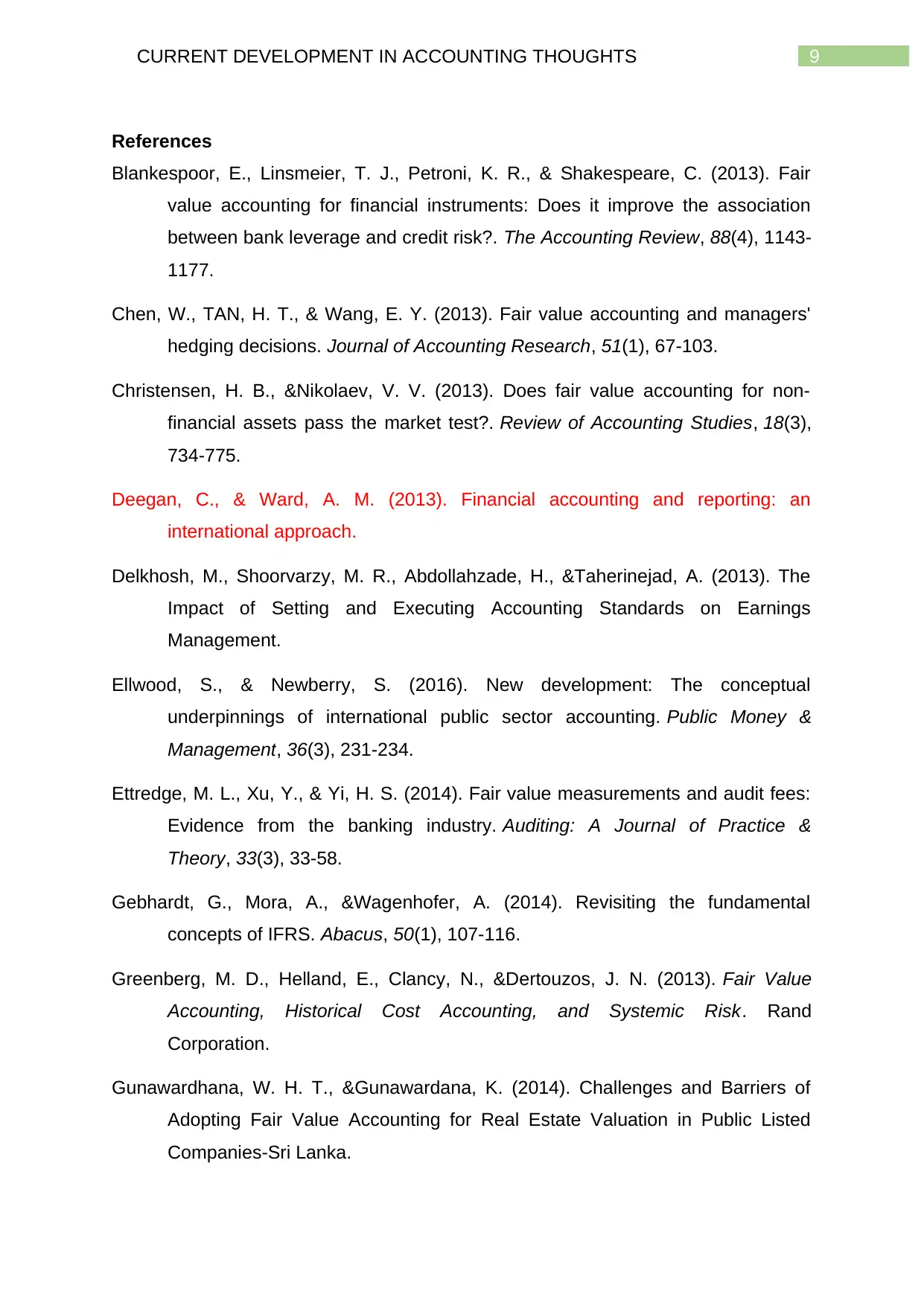
9CURRENT DEVELOPMENT IN ACCOUNTING THOUGHTS
References
Blankespoor, E., Linsmeier, T. J., Petroni, K. R., & Shakespeare, C. (2013). Fair
value accounting for financial instruments: Does it improve the association
between bank leverage and credit risk?. The Accounting Review, 88(4), 1143-
1177.
Chen, W., TAN, H. T., & Wang, E. Y. (2013). Fair value accounting and managers'
hedging decisions. Journal of Accounting Research, 51(1), 67-103.
Christensen, H. B., &Nikolaev, V. V. (2013). Does fair value accounting for non-
financial assets pass the market test?. Review of Accounting Studies, 18(3),
734-775.
Deegan, C., & Ward, A. M. (2013). Financial accounting and reporting: an
international approach.
Delkhosh, M., Shoorvarzy, M. R., Abdollahzade, H., &Taherinejad, A. (2013). The
Impact of Setting and Executing Accounting Standards on Earnings
Management.
Ellwood, S., & Newberry, S. (2016). New development: The conceptual
underpinnings of international public sector accounting. Public Money &
Management, 36(3), 231-234.
Ettredge, M. L., Xu, Y., & Yi, H. S. (2014). Fair value measurements and audit fees:
Evidence from the banking industry. Auditing: A Journal of Practice &
Theory, 33(3), 33-58.
Gebhardt, G., Mora, A., &Wagenhofer, A. (2014). Revisiting the fundamental
concepts of IFRS. Abacus, 50(1), 107-116.
Greenberg, M. D., Helland, E., Clancy, N., &Dertouzos, J. N. (2013). Fair Value
Accounting, Historical Cost Accounting, and Systemic Risk. Rand
Corporation.
Gunawardhana, W. H. T., &Gunawardana, K. (2014). Challenges and Barriers of
Adopting Fair Value Accounting for Real Estate Valuation in Public Listed
Companies-Sri Lanka.
References
Blankespoor, E., Linsmeier, T. J., Petroni, K. R., & Shakespeare, C. (2013). Fair
value accounting for financial instruments: Does it improve the association
between bank leverage and credit risk?. The Accounting Review, 88(4), 1143-
1177.
Chen, W., TAN, H. T., & Wang, E. Y. (2013). Fair value accounting and managers'
hedging decisions. Journal of Accounting Research, 51(1), 67-103.
Christensen, H. B., &Nikolaev, V. V. (2013). Does fair value accounting for non-
financial assets pass the market test?. Review of Accounting Studies, 18(3),
734-775.
Deegan, C., & Ward, A. M. (2013). Financial accounting and reporting: an
international approach.
Delkhosh, M., Shoorvarzy, M. R., Abdollahzade, H., &Taherinejad, A. (2013). The
Impact of Setting and Executing Accounting Standards on Earnings
Management.
Ellwood, S., & Newberry, S. (2016). New development: The conceptual
underpinnings of international public sector accounting. Public Money &
Management, 36(3), 231-234.
Ettredge, M. L., Xu, Y., & Yi, H. S. (2014). Fair value measurements and audit fees:
Evidence from the banking industry. Auditing: A Journal of Practice &
Theory, 33(3), 33-58.
Gebhardt, G., Mora, A., &Wagenhofer, A. (2014). Revisiting the fundamental
concepts of IFRS. Abacus, 50(1), 107-116.
Greenberg, M. D., Helland, E., Clancy, N., &Dertouzos, J. N. (2013). Fair Value
Accounting, Historical Cost Accounting, and Systemic Risk. Rand
Corporation.
Gunawardhana, W. H. T., &Gunawardana, K. (2014). Challenges and Barriers of
Adopting Fair Value Accounting for Real Estate Valuation in Public Listed
Companies-Sri Lanka.
Paraphrase This Document
Need a fresh take? Get an instant paraphrase of this document with our AI Paraphraser
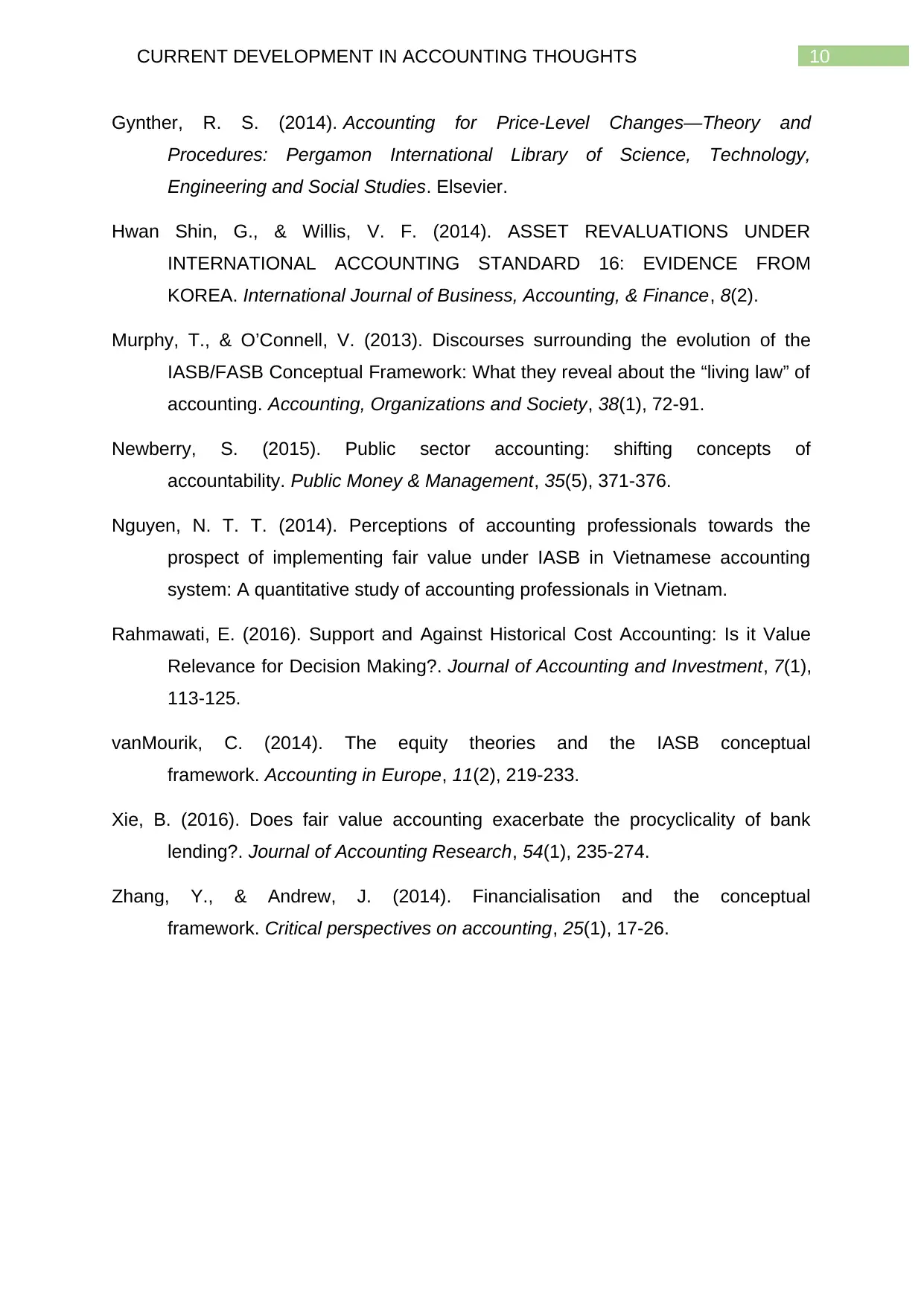
10CURRENT DEVELOPMENT IN ACCOUNTING THOUGHTS
Gynther, R. S. (2014). Accounting for Price-Level Changes—Theory and
Procedures: Pergamon International Library of Science, Technology,
Engineering and Social Studies. Elsevier.
Hwan Shin, G., & Willis, V. F. (2014). ASSET REVALUATIONS UNDER
INTERNATIONAL ACCOUNTING STANDARD 16: EVIDENCE FROM
KOREA. International Journal of Business, Accounting, & Finance, 8(2).
Murphy, T., & O’Connell, V. (2013). Discourses surrounding the evolution of the
IASB/FASB Conceptual Framework: What they reveal about the “living law” of
accounting. Accounting, Organizations and Society, 38(1), 72-91.
Newberry, S. (2015). Public sector accounting: shifting concepts of
accountability. Public Money & Management, 35(5), 371-376.
Nguyen, N. T. T. (2014). Perceptions of accounting professionals towards the
prospect of implementing fair value under IASB in Vietnamese accounting
system: A quantitative study of accounting professionals in Vietnam.
Rahmawati, E. (2016). Support and Against Historical Cost Accounting: Is it Value
Relevance for Decision Making?. Journal of Accounting and Investment, 7(1),
113-125.
vanMourik, C. (2014). The equity theories and the IASB conceptual
framework. Accounting in Europe, 11(2), 219-233.
Xie, B. (2016). Does fair value accounting exacerbate the procyclicality of bank
lending?. Journal of Accounting Research, 54(1), 235-274.
Zhang, Y., & Andrew, J. (2014). Financialisation and the conceptual
framework. Critical perspectives on accounting, 25(1), 17-26.
Gynther, R. S. (2014). Accounting for Price-Level Changes—Theory and
Procedures: Pergamon International Library of Science, Technology,
Engineering and Social Studies. Elsevier.
Hwan Shin, G., & Willis, V. F. (2014). ASSET REVALUATIONS UNDER
INTERNATIONAL ACCOUNTING STANDARD 16: EVIDENCE FROM
KOREA. International Journal of Business, Accounting, & Finance, 8(2).
Murphy, T., & O’Connell, V. (2013). Discourses surrounding the evolution of the
IASB/FASB Conceptual Framework: What they reveal about the “living law” of
accounting. Accounting, Organizations and Society, 38(1), 72-91.
Newberry, S. (2015). Public sector accounting: shifting concepts of
accountability. Public Money & Management, 35(5), 371-376.
Nguyen, N. T. T. (2014). Perceptions of accounting professionals towards the
prospect of implementing fair value under IASB in Vietnamese accounting
system: A quantitative study of accounting professionals in Vietnam.
Rahmawati, E. (2016). Support and Against Historical Cost Accounting: Is it Value
Relevance for Decision Making?. Journal of Accounting and Investment, 7(1),
113-125.
vanMourik, C. (2014). The equity theories and the IASB conceptual
framework. Accounting in Europe, 11(2), 219-233.
Xie, B. (2016). Does fair value accounting exacerbate the procyclicality of bank
lending?. Journal of Accounting Research, 54(1), 235-274.
Zhang, Y., & Andrew, J. (2014). Financialisation and the conceptual
framework. Critical perspectives on accounting, 25(1), 17-26.
1 out of 11
Related Documents
Your All-in-One AI-Powered Toolkit for Academic Success.
+13062052269
info@desklib.com
Available 24*7 on WhatsApp / Email
![[object Object]](/_next/static/media/star-bottom.7253800d.svg)
Unlock your academic potential
Copyright © 2020–2025 A2Z Services. All Rights Reserved. Developed and managed by ZUCOL.




